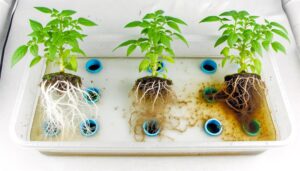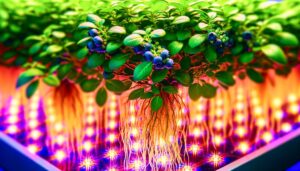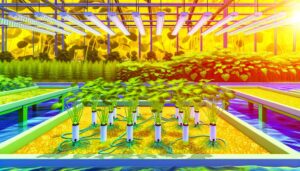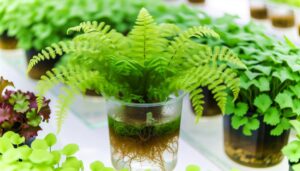Hydroponics 101: Produce Much More Food by 20-25
Hydroponics can generate remarkably higher food yields compared to traditional farming, with production rates reaching up to ten times more per unit area. For example, Deep Water Culture systems can yield 25% more lettuce per square meter, while Aeroponics may produce an additional 30% herbs like basil versus other methods.
This efficiency stems from precise nutrient management and controlled environmental conditions, leading to faster growth cycles and greater crop density. Enhanced resource utilization and reduced water consumption make hydroponics an essential technology for sustainable agriculture, particularly in water-scarce regions.
Explore further to understand how these systems achieve such significant gains in food production.
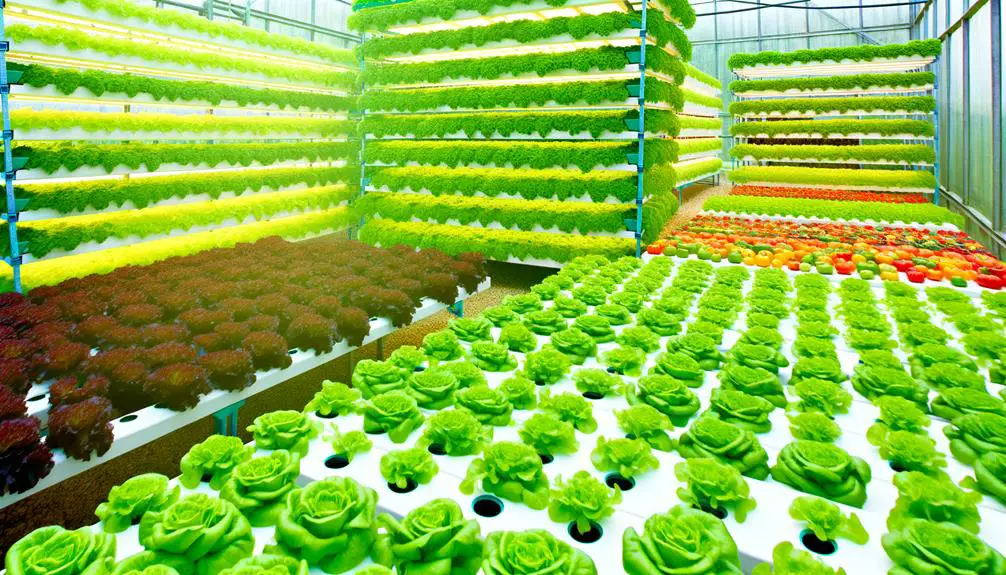
Key Takeaways
- Hydroponics can produce up to 10 times more food per unit area than traditional farming.
- Water consumption in hydroponics is reduced by about 90%, making it highly efficient.
- DWC systems yield up to 25% more lettuce per square meter than soil.
- Aeroponic systems can produce 30% more herbs like basil compared to other methods.
Hydroponics Overview
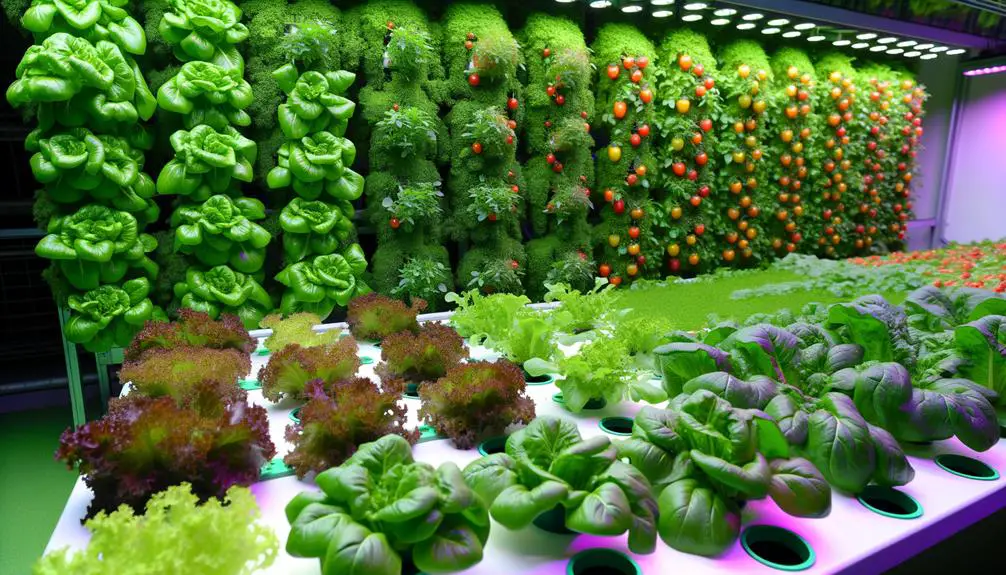
Hydroponics, the method of growing plants without soil by using mineral nutrient solutions in an aqueous solvent, offers a highly efficient and sustainable approach to food production.
This technique leverages precise control over nutrient delivery and environmental conditions, resulting in accelerated plant growth and higher yields. According to the United Nations Food and Agriculture Organization, hydroponic systems can produce up to ten times more food per unit area compared to traditional soil farming.
Additionally, hydroponics reduces water consumption by approximately 90%, a critical factor in regions facing water scarcity. The absence of soil also minimizes the risk of soil-borne diseases, lowering the need for chemical pesticides.
Consequently, hydroponics presents a promising solution for meeting the escalating global food demand efficiently.
Types of Hydroponic Systems
There are several types of hydroponic systems, each offering unique advantages and suited for different scales and types of crop production. These systems can be tailored to optimize resource efficiency, growth rates, and yield quality.
Key systems include:
- Nutrient Film Technique (NFT): A thin film of nutrient solution flows over the roots of plants, ideal for leafy greens and herbs.
- Deep Water Culture (DWC): Plants are suspended in oxygenated nutrient-rich water, promoting rapid growth and suitable for larger produce.
These systems leverage technology to maximize productivity, making them pivotal in modern agricultural innovation.
Yield Comparisons
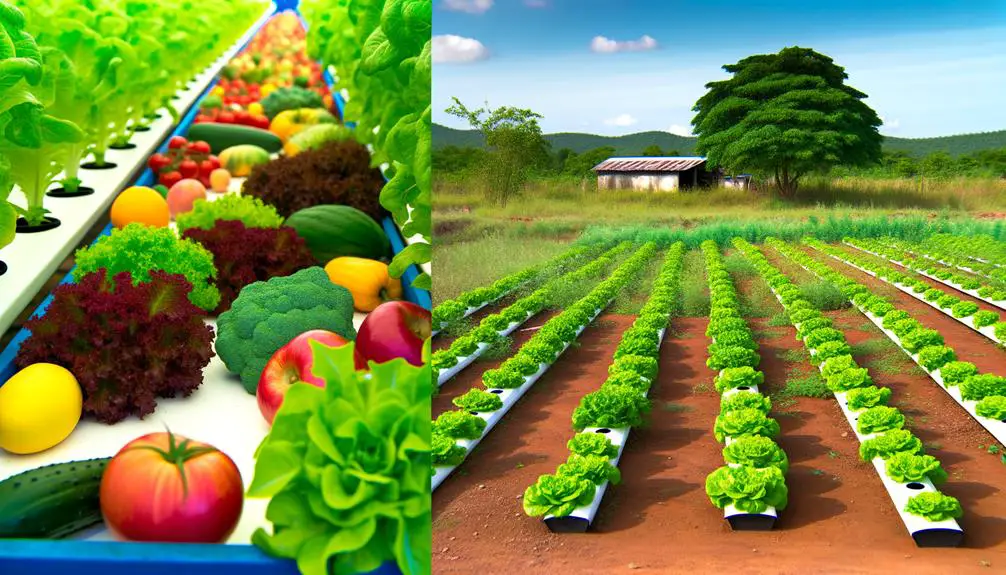
Comparing yield outcomes across different hydroponic systems reveals significant variations in productivity and efficiency, impacted by factors such as crop type, system design, and nutrient management.
For instance, studies indicate that Deep Water Culture (DWC) systems can yield up to 25% more lettuce per square meter compared to traditional soil-based methods.
Similarly, Nutrient Film Technique (NFT) systems are particularly effective for leafy greens, achieving higher output per unit area due to optimized nutrient delivery.
Aeroponics, known for its high oxygenation levels, can produce up to 30% more herbs like basil compared to other hydroponic methods.
These data underscore the importance of tailored system selection to maximize yield potential, emphasizing the need for precise nutrient and environmental control.
Key Influencing Factors
The efficacy of hydroponics food production is greatly influenced by the quality of the nutrient solution and the levels of light exposure.
Ideal nutrient concentrations are essential for plant growth, as evidenced by studies indicating a 25% increase in yield with properly balanced solutions.
Similarly, controlled light exposure directly impacts photosynthetic efficiency, with research showing that plants receiving 12-16 hours of light per day exhibit ideal growth rates.
Nutrient Solution Quality
Maintaining ideal nutrient solution quality in hydroponics is essential, as it directly influences plant growth, yield, and overall health.
The precision and consistency of nutrient delivery systems play a pivotal role in enhancing hydroponic food production.
Critical factors include:
- Nutrient Concentration: Maintaining precise levels of macro and micronutrients to prevent deficiencies or toxicities.
- pH Balance: Ensuring the nutrient solution remains within an appropriate pH range (typically 5.5 to 6.5) to facilitate nutrient uptake.
Light Exposure Levels
In addition to nutrient solution quality, optimizing light exposure levels is fundamental to maximizing plant photosynthesis and growth in hydroponic systems.
Light intensity, duration, and spectrum are critical parameters that directly affect yield. Research indicates that plants grown under controlled LED lighting, which can be fine-tuned to emit specific wavelengths, exhibit a 20-30% increase in growth rates compared to traditional lighting.
Additionally, implementing photoperiod strategies, such as 18-hour light cycles, can further enhance biomass accumulation. Balancing light energy efficiency with plant demands not only promotes accelerated growth but also minimizes operational costs.
Given these considerations, precise light management remains a pivotal element in advancing hydroponic food production to meet future agricultural demands.
Crop Varieties
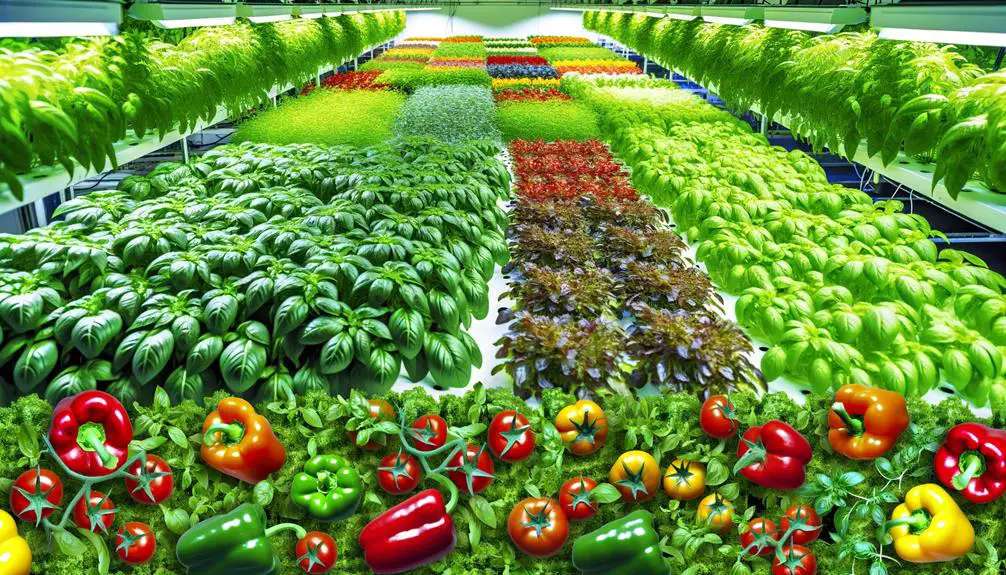
Hydroponic systems support a diverse array of crop varieties, with leafy greens, herbs, and certain fruiting plants being the most popular due to their adaptability and high market demand.
Comparative analyses indicate that the nutritional value of hydroponically grown crops can equal or exceed that of their soil-grown counterparts, depending on the nutrient solutions used.
Additionally, the efficiency of growth cycles in hydroponics often surpasses traditional farming methods, reducing time to harvest and enhancing yield predictability.
Popular Hydroponic Crops
Several crop varieties thrive exceptionally well in hydroponic systems, including leafy greens, herbs, and certain fruiting plants.
Leafy greens like lettuce and spinach demonstrate rapid growth and high yields, benefiting from controlled nutrient supply and optimized light conditions.
Herbs such as basil and mint exhibit enhanced flavor profiles and vigorous growth due to consistent nutrient availability.
Fruiting plants, especially tomatoes and cucumbers, achieve significant production rates when supported by hydroponic techniques.
- Leafy Greens: Lettuce, Spinach, Kale
- Herbs: Basil, Mint, Parsley
Data indicates that hydroponic systems can produce up to 11 times more lettuce per square foot annually compared to traditional farming.
This efficiency, combined with reduced water usage, underscores hydroponics' potential in sustainable agriculture.
Nutritional Value Comparison
A comparative analysis of nutritional content reveals that hydroponically grown crops can match or even exceed the nutrient density of their soil-grown counterparts.
Studies indicate that hydroponically cultivated leafy greens, such as spinach and lettuce, often contain higher concentrations of vitamins A and C. Additionally, hydroponic tomatoes have demonstrated elevated levels of antioxidants like lycopene.
Controlled environments allow for the precise management of nutrient solutions, optimizing mineral uptake and enhancing phytochemical profiles. For instance, research shows that hydroponically grown basil exhibits up to 20% more essential oils, contributing to its enhanced flavor and medicinal properties.
These data substantiate the potential for hydroponic systems to produce not only equivalent but nutritionally superior crops, addressing both health and sustainability concerns.
Growth Cycle Efficiency
Building on the enhanced nutritional profiles of hydroponically grown crops, the efficiency of their growth cycles demonstrates significant advantages across various crop varieties. Hydroponic systems maximize resource utilization and accelerate growth phases, yielding a higher output per square meter.
For instance, lettuce can reach harvest maturity in as little as 30 days, compared to 45-60 days in soil-based agriculture. This accelerated growth is attributed to:
- Precise nutrient delivery: Tailored nutrient solutions guarantee ideal plant health.
- Controlled environment: Temperature, humidity, and light are meticulously regulated.
These efficiencies not only enhance productivity but also support sustainable agricultural practices, vital for meeting the growing global food demand.
Space Efficiency
Maximizing yield per square foot, hydroponics systems demonstrate superior space efficiency compared to traditional soil-based agriculture.
Through vertical farming techniques, hydroponics can increase plant density, achieving yields up to ten times higher per unit area.
For example, a single square meter of hydroponic basil can produce 20-25 kilograms annually, compared to 3-5 kilograms in soil-based systems. This efficiency is attributed to the elimination of soil, precise nutrient delivery, and optimized growing conditions.
Additionally, hydroponic systems can be implemented in urban settings, utilizing underused spaces such as rooftops and warehouses.
As a result, hydroponics offers a viable solution for addressing food production challenges in densely populated areas, thereby contributing to sustainable urban agriculture and food security.
Case Studies

Numerous real-world examples illustrate the efficiency and scalability of hydroponic systems in urban agriculture, demonstrating their potential to revolutionize food production.
For instance, the Edenworks aquaponic farm in Brooklyn achieves a remarkable yield of 50,000 pounds of produce annually on a mere 12,000 square feet.
Similarly, AeroFarms' vertical farming in Newark produces up to 2 million pounds of leafy greens per year within a 70,000-square-foot facility.
- Edenworks: 50,000 pounds/year on 12,000 sq ft.
- AeroFarms: 2 million pounds/year on 70,000 sq ft.
These case studies underscore hydroponics' high productivity and space efficiency, offering compelling evidence for its transformative impact on urban agriculture.
Future Prospects
Considering the rapid advancements in technology and increasing urbanization, the future prospects of hydroponic food production appear exceedingly promising, with potential breakthroughs in automation, energy efficiency, and crop variety.
Emerging technologies such as AI-driven climate control systems and robotic planting/harvesting mechanisms could enhance productivity by 20-30%.
Innovations in LED lighting and renewable energy integration may reduce operational costs by up to 40%.
Additionally, genetic engineering could expand the range of crops suitable for hydroponic growth, potentially increasing yield diversity.
Urban vertical farming could become integral to city planning, reducing the carbon footprint associated with food transportation.
Conclusion
Hydroponics demonstrates significant potential in maximizing food production through controlled environments and efficient use of resources.
For example, a case study of a commercial hydroponic farm in Arizona revealed lettuce yields of up to 20 times greater per acre compared to traditional soil farming.
The combination of advanced technology, ideal nutrient delivery, and space efficiency positions hydroponics as a sustainable solution to meet future food demands, particularly in urban settings and areas with limited arable land.

